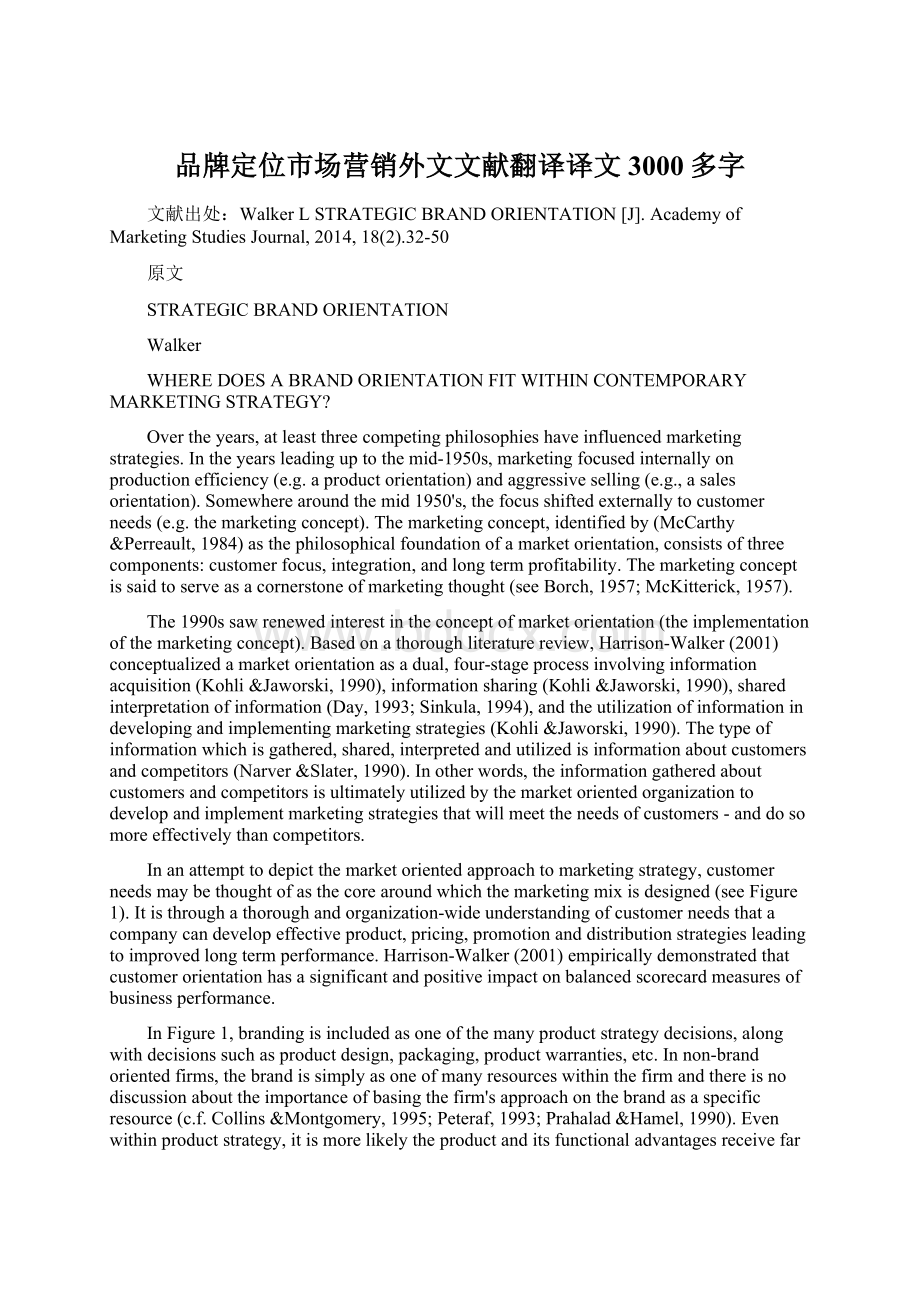品牌定位市场营销外文文献翻译译文3000多字Word下载.docx
《品牌定位市场营销外文文献翻译译文3000多字Word下载.docx》由会员分享,可在线阅读,更多相关《品牌定位市场营销外文文献翻译译文3000多字Word下载.docx(7页珍藏版)》请在冰豆网上搜索。

Overtheyears,atleastthreecompetingphilosophieshaveinfluencedmarketingstrategies.Intheyearsleadinguptothemid-1950s,marketingfocusedinternallyonproductionefficiency(e.g.aproductorientation)andaggressiveselling(e.g.,asalesorientation).Somewherearoundthemid1950'
s,thefocusshiftedexternallytocustomerneeds(e.g.themarketingconcept).Themarketingconcept,identifiedby(McCarthy&
Perreault,1984)asthephilosophicalfoundationofamarketorientation,consistsofthreecomponents:
customerfocus,integration,andlongtermprofitability.Themarketingconceptissaidtoserveasacornerstoneofmarketingthought(seeBorch,1957;
McKitterick,1957).
The1990ssawrenewedinterestintheconceptofmarketorientation(theimplementationofthemarketingconcept).Basedonathoroughliteraturereview,Harrison-Walker(2001)conceptualizedamarketorientationasadual,four-stageprocessinvolvinginformationacquisition(Kohli&
Jaworski,1990),informationsharing(Kohli&
Jaworski,1990),sharedinterpretationofinformation(Day,1993;
Sinkula,1994),andtheutilizationofinformationindevelopingandimplementingmarketingstrategies(Kohli&
Jaworski,1990).Thetypeofinformationwhichisgathered,shared,interpretedandutilizedisinformationaboutcustomersandcompetitors(Narver&
Slater,1990).Inotherwords,theinformationgatheredaboutcustomersandcompetitorsisultimatelyutilizedbythemarketorientedorganizationtodevelopandimplementmarketingstrategiesthatwillmeettheneedsofcustomers-anddosomoreeffectivelythancompetitors.
Inanattempttodepictthemarketorientedapproachtomarketingstrategy,customerneedsmaybethoughtofasthecorearoundwhichthemarketingmixisdesigned(seeFigure1).Itisthroughathoroughandorganization-wideunderstandingofcustomerneedsthatacompanycandevelopeffectiveproduct,pricing,promotionanddistributionstrategiesleadingtoimprovedlongtermperformance.Harrison-Walker(2001)empiricallydemonstratedthatcustomerorientationhasasignificantandpositiveimpactonbalancedscorecardmeasuresofbusinessperformance.
InFigure1,brandingisincludedasoneofthemanyproductstrategydecisions,alongwithdecisionssuchasproductdesign,packaging,productwarranties,etc.Innon-brandorientedfirms,thebrandissimplyasoneofmanyresourceswithinthefirmandthereisnodiscussionabouttheimportanceofbasingthefirm'
sapproachonthebrandasaspecificresource(c.f.Collins&
Montgomery,1995;
Peteraf,1993;
Prahalad&
Hamel,1990).Evenwithinproductstrategy,itismorelikelytheproductanditsfunctionaladvantagesreceivefargreaterattentionthanthebrand(Urde,1999,p.l19).Theproblemisthatfunctionaladvantagescangenerallybeimitated(Urde,1999,p.l19).
Thequestionthenbecomeswhetheramarketorientedfirmcanalsobebrandorientedand,ifso,wherebrandorientationcomesintothepicture.Certainly,anorganizationcannotfocusonabrandwithoutmeetingcustomerneeds.Customerneedsmustremainatthecore.Thisdoesnotmeanthatthecustomerisking;
itmeansthatitisimperativeforthecompanytohaveathoroughunderstandingofcustomerneedsinordertodesignaneffectivemarketingstrategy.Soinourrevisedfigure,customerneedsremainatthecore.ForaproperadaptationofourmodelinFigure1,weareprovideddirectionbyWongandMerrilees(2007,p.388)whoexplainthat"
Ifeachelementofamarketingmixalignstothebrand,thenconsequentlytheywillbealignedtoeachotherandproduceamoreconsistentandrobustperformance."
Inorderforthebrandtofunctionasthebasisoftheorganization'
sresponses(Gromark&
Melin,2005),weneedtoaddasecondconcentriccirclearoundthecore(seeFigure2).Thesecondconcentriccircleisthebrandstrategy.Thismakesabsolutesensefromamarketingstrategyperspectivewhenoneconsidersthatcriticalbrandingdecisions,suchaspositioning,aredependeduponindesigningthemarketingmix.Thatis,strategicpositioninginvolvesdesigningtheproductandthemarketingmixtofitauniquepositionintheconsumer'
smind.Therefore,onceconsumerinformationiscollectedandprocessed,thepositioningstrategyisformulatedandthemarketingmixisdevelopedtocommunicatethebrand'
suniqueposition.
Insupportofthisconceptualization,indicatingthatnotonlyareamarketorientationandabrandorientationnotmutuallyexclusive,butthatabrandorientationpositivelyimpactstheeffectivenessofthemarketingstrategy(Wong&
Merrilees,2008),Urde(1999,p.18)providesthefollowingquotefromOlleTegstam,SeniorVicePresidentatNestle:
Anorganizationcanneveronlybebrand-oriented.Therehavetobeproductsthataredemandedandthatworktogetherwithyourbrand.Tobebrand-orientedismarketorientation"
plus"
.
FACTORSAFFECTINGABRANDORIENTATION
Nowadaysmostcompaniesunderstandthatbrandorientationiscrucialtodevelopingstrongbrandsandareconvincedthatstrongbrandscanprovidesustainablecompetitiveadvantages(Gromark&
Melin,2011).Infact,"
brandshavebecomethefocalpointofmanyacompany'
smarketingeffortsandareseenasasourceofmarketpower,competitiveleverageandhigherreturns"
(Dawar,2004,p.31).Butwhatfactorsaffectacompany'
sbrandorientation?
Byreviewingtheexistingmarketingandbusinessliteratureitispossibletoidentifyanumberofpotentialantecedentstoabrandorientation.Inthisstudy,eightfactorsareidentifiedasfactorspotentiallyinfluencingabrandorientation.TheconceptualmodelshowingthepotentialantecedentsofabrandorientationispresentedinFigure3.Potentialantecedentsinclude:
thesizeofthecompany,brandbarriers,servicescomponent,explorationofbrandidentity,brandresearch,yearsofplanningandinvestment,expansiongrowthintention,andbrandmanagementassessment.Inthefollowingsections,weintroduceeachofthepotentialantecedentsandsetfortharesearchpropositionwithregardtoitsexpectedeffectonabrandorientation.
SizeofCompany
Thefirstfactoridentifiedasapotentialantecedentofabrandorientationisthesizeofthecompany.Severalresearchers(Baumgarth,2010,Krake,2005,Wong&
Merrilees,2005)reportthatsmallercompaniesarelesslikelytobebrandorientedthanlargercompanies.Forexample,inastudyofbusiness-to-businesscompanies,Baumgarth(2010)dividedsamplecompaniesinto"
successful"
and"
unsuccessful"
groupsonthebasisofamarketperformanceindex,andfoundthatwhileallcompaniesinthesamplereportedlowlevelsofbrandorientation,smallercompaniesexhibitedlowerlevelsofbrandorientationthanlargerones.Inthisstudy,thesizeofthecompanywasmeasuredbothintermsofturnoverandnumberofemployees(Baumgarth,2010).
WongandMerrilees(2005)provideanexplanationastowhysmallercompaniestendtobelessbrandorientedthanlargerones;
thatis,smallercompanieshavealowerlevelofbrandorientationthanlargeronesbecausetheyperceivethattheyhaveneitherthetimenortheresourcestoconductbrandingactivities.Theauthors(Wong&
Merrilees,2005,p.156)notethatnumerousstudies"
haveidentifiedmanySMEsfailingtofullyinvestinmostbusinessassets,includingadvertising,informationtechnologyandtraining,andtoperceivesuchinvestmentsascostsinstead."
InanotherstudybyKrake(2005),qualitativeresearchwasconductedwith10mostlymediumsizedcompanies.Justoverhalfofthecompaniesstudiedadmittedthatthey"
dosomethingaboutbrandmanagement"
and,followingclarificationoftheresearchquestion,threemaintainedthatbrandmanagementhadnopartintheirdailyorweeklyoperations(Krake,2005,p.230).Krake(2005)furtherfoundthatotherthanthedirectors/owners,noonewithintheseorganizationswasspecificallyconcernedwithbrandmanagement,norwasitwidelydiscussedorcommunicated.Krake(2005)concludesthatinmanySMEcompanies,brandmanagementreceiveslittleornoattentioninthedailyrunofaffairs.AlthoughtheownersordirectorsofSMEsaretheonestotaketheleadinthisarea,theyeitherseldomhavethetimeforitorarenotevenawareof"
brandmanagement"
asaconcept(Krake,2005).
BasedontheresearchfindingsofBaumgarth(2010),Krake(2005),andWongandMerrilees(2005),itseemsthatsmallercompaniesarelessbrand-orientedthanlargerones.Thisleadstothefollowingresearchproposition.
PI:
Thesizeofthecompanyhasapositiveeffectonthecompany'
slevelofbrandorientation.
BrandBarriers
PerhapsrelatedtothesizeofthecompanyistheconstructofbrandbarriersidentifiedbyWongandMerrilees(2005).'
Brandbarriers'
refertoobstaclesthathindersmallerfirmsinparticularincarryingoutbusinessactivitiesbasedonthebrand.Theobstaclesprimarilyinvolvelimitationsonfinancialandhumanresources,aswellastime(Krake,2005,Wong&
Merrilees,2005).Thebrandbarriersconstructisidentifiedseparatelyfromthesizeofthecompanysincelargerfirmsmayalsobeaffectedbyresourcelimitationsforanumberofreasonsincludingthenegativeeffectsofuncontrollablefactorsinvarioussectorsoftheexternalenvironment.Thesemayincludeaweakeconomy,increasingcostsofdoingbusiness,theimpositionofnewlegalrestrictionsorrequirements,andsoforth.Theunavailabilityoffinancialandhumanresourcesoftenforcesfirmstoadoptashorttermfocusratherthanalongtermbrandingstrategyandtou